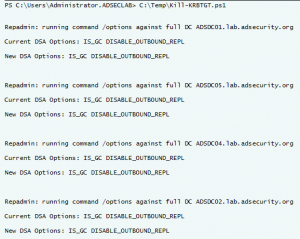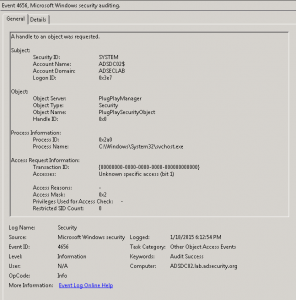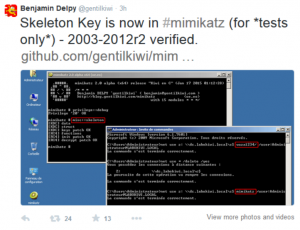At the Microsoft Ignite conference this week, there are several sessions covering Windows 10 features. One of biggest changes in Windows 10 is the new credential management method and the related “Next Generation Credential”, now named Microsoft Passport. There hasn’t been much information on how the new credential system works, so I challenged myself to …
Category: Microsoft Security
May 03 2015
Detecting Forged Kerberos Ticket (Golden Ticket & Silver Ticket) Use in Active Directory
Over the last 6 months, I have been researching forged Kerberos tickets, specifically Golden Tickets, Silver Tickets, and TGTs generated by MS14-068 exploit code (a type of Golden Ticket). I generated forged Kerberos tickets using Mimikatz (Mimikatz Command Reference) and MS14-068 exploits and logged the results. Over the course of several weeks, I identified anomalies …
Apr 12 2015
SPN Scanning – Service Discovery without Network Port Scanning
The best way to discover services in an Active Directory environment is through what I call “SPN Scanning.” The primary benefit of SPN scanning for an attacker over network port scanning is that SPN scanning doesn’t require connections to every IP on the network to check service ports. SPN scanning performs service discovery via LDAP …
Mar 22 2015
Bypassing EMET 5.2 Security Protection
While EMET 5.2 may only be about a week old, there is already information about one way tor bypassing one of EMET’s security protection methods. r41p41 posted information about ROP bypass in the latest EMET version, 5.2. TLDR: EMET 5.2 can be bypassed with ease by jumping past its hooks using simple ROP 19th March …
Mar 16 2015
Microsoft EMET 5.2 Now Available!
Microsoft Security Research and Defense blog posts that Microsoft EMET 5.2 is now available! Following is the list of the main changes and improvements: Control Flow Guard: EMET’s native DLLs have been compiled with Control Flow Guard (CFG). CFG is a new feature introduced in Visual Studio 2015 (and supported by Windows 8.1 and …
Feb 18 2015
Interesting KRBTGT Password Reset Behavior
Following up on Twitter conversations (@passingthehash, @scriptjunkie1, gentilkiwi, etc) on the new KRBTGT Password Reset Script and Skip Duckwall’s (@passingthehash) blog post on how KRBTGT password changes work. Microsoft KB2549833 states that the KRBTGT password is set automatically to a random string when a new password is entered. This occurs because there is special logic …
Feb 11 2015
MS15-011 & MS15-014: Microsoft Active Directory Group Policy (GPO) Vulnerabilities Patched
On February’s Patch Tuesday (2/11/2015), Microsoft released two patches that fix issues with the way Group Policy is processed by the client. Interestingly enough, one of these vulnerabilities (MS15-014) makes the other one (MS15-011) not only feasible, but quite capable. The Attack Scenario: An attacker leverages the vulnerability described in MS15-014 to prevent/stop Group Policy …
Jan 19 2015
Attackers Can Now Use Mimikatz to Implant Skeleton Key on Domain Controllers & BackDoor Your Active Directory Forest
Once an attacker has gained Domain Admin rights to your Active Directory environment, there are several methods for keeping privileged access. Skeleton Key is an ideal persistence method for the modern attacker. More information on Skeleton Key is in my earlier post. Note that the behavior documented in this post was observed in a lab …
Jan 16 2015
Active Directory Domain Controller Skeleton Key Malware & Mimikatz
Dell SecureWorks posted about the Skeleton Key malware discovered at a customer site. The Skeleton Key malware is installed on one or multiple Domain Controllers running a supported 64bit OS. The malware “patches” the security system enabling a new master password to be accepted for any domain user, including admins. This enables the attacker to …
Jan 07 2015
PowerShell Security: Execution Policy is Not An Effective Security Strategy – How to Bypass the PowerShell Execution Policy
If you have worked with PowerShell recently, you may have run into an Execution Policy message: c:\temp\Find-PSServiceAccounts.ps1 : File C:\temp\Find-PSServiceAccounts.ps1 cannot be loaded because running scripts is disabled on this system. For more information, see about_Execution_Policies at http://go.microsoft.com/fwlink/?LinkID=135170. At line:1 char:1 + c:\temp\Find-PSServiceAccounts.ps1 + ~~~~~~~~~~~~~~~~~~~~~~~~~~~~~~~~~~ + CategoryInfo : SecurityError: (:) [], PSSecurityException + FullyQualifiedErrorId : …







Recent Comments